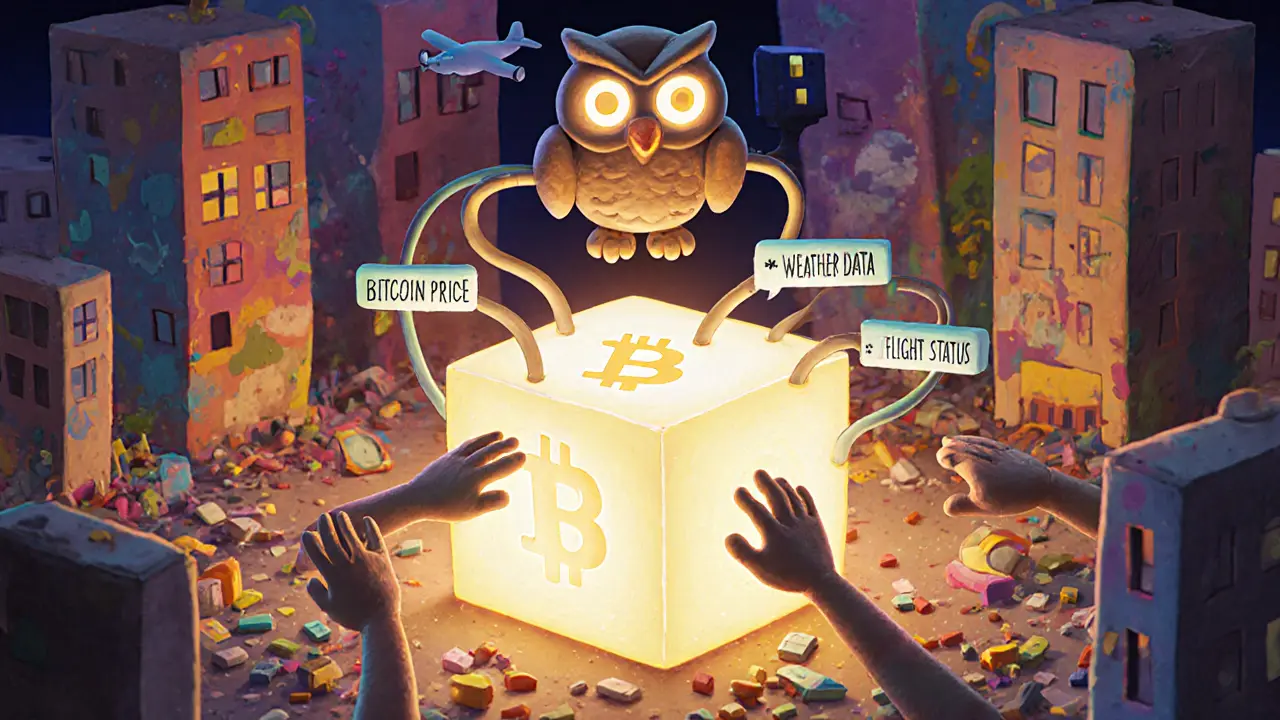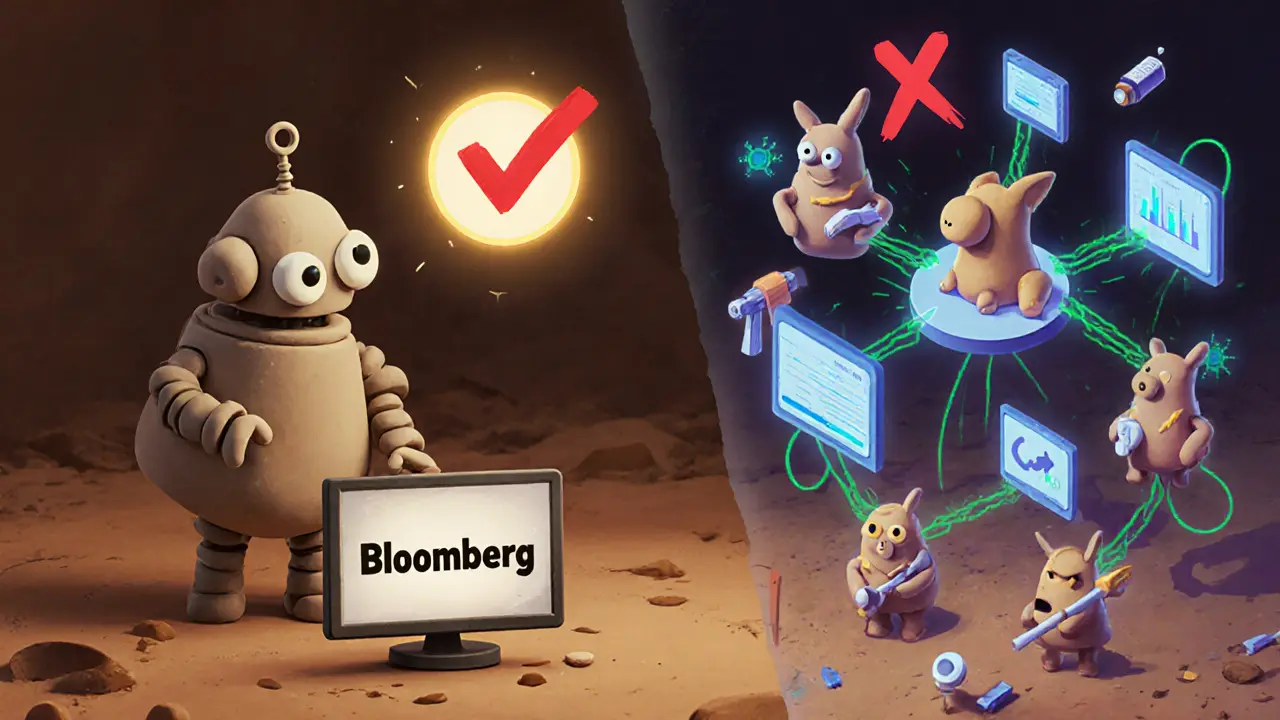What Are Blockchain Oracles? A Clear Guide to How They Connect Smart Contracts to the Real World
 Jun, 16 2025
Jun, 16 2025
Oracle Cost Calculator
Estimate Your Oracle Costs
Estimated Costs
Blockchain oracles are the bridge between smart contracts and the real world. Without them, smart contracts would be stuck inside their own digital bubble, unable to react to anything happening outside the blockchain-like the price of Bitcoin, the weather in New York, or whether a flight was delayed. They’re not data sources themselves. They’re the middlemen that go out, find the truth, verify it, and bring it back to the blockchain so smart contracts can act on it.
Why Do Blockchain Oracles Even Exist?
Blockchains are designed to be deterministic. That means every node in the network must agree on the exact same outcome when given the same input. If one node says a contract should pay out $10,000 because the stock price hit $500, and another says it didn’t, the whole system breaks. That’s why blockchains can’t just reach out and grab live data from the internet on their own. They need a trusted way to get that information. This is called the oracle problem. It’s not a bug-it’s a feature of how blockchains work. But it’s also the biggest roadblock to real-world use. If you want a smart contract to automatically pay out crop insurance when a drought hits, you need to know the actual rainfall data. Who tells the blockchain that? That’s where oracles come in.How Do Blockchain Oracles Work?
Think of an oracle as a two-part system: one part lives on the blockchain (the oracle contract), and the other part lives off-chain (the oracle node). Here’s how it works step by step:- A smart contract needs real-world data-say, the current price of ETH in USD.
- The contract sends a request to its oracle contract on the blockchain.
- The oracle contract triggers an off-chain oracle node to fetch that data from an API, like CoinGecko or Bloomberg.
- The node retrieves the price, verifies it against multiple sources, and signs it with its private key.
- The signed data is sent back to the on-chain oracle contract.
- The smart contract receives the data, checks the signature, and executes its logic-like triggering a trade or payout.
Types of Blockchain Oracles
Not all oracles are the same. They’re built for different jobs:- Inbound oracles bring data into the blockchain. Think stock prices, weather reports, or sports scores. These are the most common.
- Outbound oracles send data out. For example, a smart contract could trigger a bank transfer after a payment is confirmed on-chain.
- Compute-enabled oracles don’t just fetch data-they process it. Need to calculate a complex risk score from 10 different inputs? A compute oracle does it off-chain and returns the result.
- Cross-chain oracles connect different blockchains. Chainlink’s CCIP protocol lets data from Ethereum trigger actions on Solana or Polygon.
Centralized oracles rely on one source-like a single API from a company. They’re simple but risky. If that API goes down or gets hacked, the whole smart contract fails. That’s what happened in the 2022 Euler Finance attack, where a manipulated price feed led to $197,000 in losses.
Decentralized oracle networks (DONs) fix this by using multiple independent nodes and data sources. Chainlink, for example, pulls price data from over 1,000 nodes and 50+ data providers. No single point of failure. That’s why 92% of DeFi protocols use decentralized oracles.

Who’s Leading the Market?
Chainlink dominates. As of late 2023, it handles over 70% of the decentralized oracle market, secures more than $10 billion in smart contract value, and supports over 1,400 projects across Ethereum, Polygon, BNB Chain, and others. Its documentation is rated 4.7/5 by developers. Its Discord has over 85,000 members. Its uptime is 99.98%.Other players exist, but they’re far behind:
- API3 (12% market share) lets data providers run their own oracle nodes directly, cutting out middlemen.
- Pyth Network (9%) specializes in high-speed financial data and is backed by major exchanges like FTX and Jump Crypto.
- Band Protocol (5%) focuses on mobile and emerging markets, with strong support in Asia.
Enterprise adoption is growing fast. According to Gartner, 63% of Fortune 500 companies are testing oracle-integrated blockchain solutions. And with the EU’s MiCA regulation coming in 2024, financial oracles will have to meet strict data validation standards-something Chainlink and others are already building into their systems.
Real-World Use Cases
Oracles aren’t theoretical. They’re already powering real applications:- DeFi lending: Aave uses Chainlink oracles across 15 blockchains to price assets and manage collateral. Over $7.2 billion is locked in without major oracle-related issues.
- Insurance: Climate Risk Insurance uses weather oracles to automatically pay farmers when rainfall drops below a threshold-no paperwork, no delays.
- Supply chains: A logistics company tracks temperature-sensitive cargo using IoT sensors connected to oracles. If the fridge breaks, the contract triggers a replacement order.
- Sports betting: Smart contracts settle bets in real time based on live game data pulled from official APIs.
These aren’t prototypes. They’re live, running, and handling millions in value.

Challenges and Risks
Despite their power, oracles aren’t perfect.First, gas fees. Every oracle request on Ethereum costs between $0.45 and $2.50. For apps that need frequent updates-like a trading bot-that adds up fast.
Second, data quality. Oracles can’t verify subjective data. Can they tell if a tweet is fake? Or if a news article is misleading? No. That’s why they’re great for price feeds and sensor data but struggle with social sentiment or unstructured content.
Third, trust still matters. Even decentralized oracles shift trust from data sources to the oracle network itself. As UC Berkeley’s Dr. David Wagner put it: “No oracle solution can perfectly solve the trust problem-it merely shifts the trust.”
And yes, attacks happen. Oracle-related exploits caused $146 million in DeFi losses in 2022, according to Chainalysis. But most of those were against poorly designed contracts, not the oracle networks themselves. Well-built DONs like Chainlink have never been successfully compromised since 2021.
Getting Started
If you’re a developer wanting to use an oracle:- Choose a network. Chainlink is the safest bet for beginners.
- Set up a dev environment with Solidity and Hardhat.
- Deploy a simple contract that requests ETH/USD price data.
- Fund it with LINK tokens (Chainlink’s native token) to pay for the oracle service.
- Use Chainlink’s docs-rated 4.6/5 by developers-to configure the request.
Most developers report getting a basic setup working in 3 to 5 hours. Complex integrations might take 10-20 hours, but that’s still far faster than building your own oracle from scratch.
Community support is strong. Chainlink’s GitHub has over 1,200 reviews and 14,000+ answered questions. Their Discord is active 24/7. You’re not alone if you get stuck.
The Future of Oracles
The next wave is about privacy and scalability. Chainlink’s DECO protocol, launched in early 2023, lets oracles pull data from HTTPS websites (like bank statements or tax records) without revealing the full content-just the proof that it’s true. That’s huge for enterprise use cases.And the market is exploding. The decentralized oracle market was worth $385 million in 2022. By 2025, it’s projected to hit $1.2 billion. Some analysts predict oracles will handle over $10 trillion in transaction value by 2030.
They’re not a temporary fix. Oracles are becoming foundational infrastructure-like DNS for the internet. Without them, smart contracts can’t scale beyond simple bets and token swaps. With them, they can power insurance, banking, logistics, and more.
Blockchains give us trustless automation. Oracles give us access to reality. Together, they’re turning code into a force that changes how the real world works.
What is the oracle problem in blockchain?
The oracle problem is the challenge of getting reliable, real-world data into a blockchain so smart contracts can act on it. Blockchains are closed systems-they can’t access external data like stock prices or weather reports on their own. Oracles solve this by acting as trusted intermediaries that fetch, verify, and deliver off-chain data to on-chain smart contracts.
Are blockchain oracles safe?
Decentralized oracle networks (DONs) like Chainlink are very secure. They use multiple independent nodes, cryptographic signatures, and consensus mechanisms to prevent manipulation. Centralized oracles, which rely on a single data source, are risky and have caused major DeFi hacks. Always use decentralized oracles for critical applications.
What’s the difference between inbound and outbound oracles?
Inbound oracles bring data from the outside world into a smart contract-like a temperature reading triggering an insurance payout. Outbound oracles send data from the blockchain to the outside world-like a smart contract authorizing a bank transfer after a payment is confirmed. Most smart contracts use inbound oracles, but outbound ones are growing fast.
Can oracles handle any kind of data?
Oracles work best with structured, verifiable data-like prices, weather, or sensor readings. They struggle with unstructured data like social media sentiment or news articles, because there’s no clear way to verify truth. For subjective inputs, human judgment or hybrid systems are still needed.
How much does it cost to use a blockchain oracle?
On Ethereum, a single oracle request typically costs between $0.45 and $2.50 in gas fees, plus a small payment in LINK tokens (Chainlink’s native token). Costs vary by network and data complexity. High-frequency applications can add up, so many projects use batched requests or Layer 2 solutions to reduce expenses.
What happens if an oracle fails?
If a centralized oracle fails, the smart contract may stop working or act on wrong data, leading to losses. Decentralized networks avoid this by using redundancy-multiple nodes and data sources. If one node goes down or provides bad data, others override it. Chainlink’s network, for example, uses over 1,000 nodes to ensure reliability.
Do I need to know how to code to use oracles?
You need coding skills to build smart contracts that use oracles-usually Solidity and tools like Hardhat. But if you’re just using a DeFi app like Aave or Synthetix, you don’t need to code at all. The oracle integration is handled behind the scenes. Developers build the systems; users benefit from them.